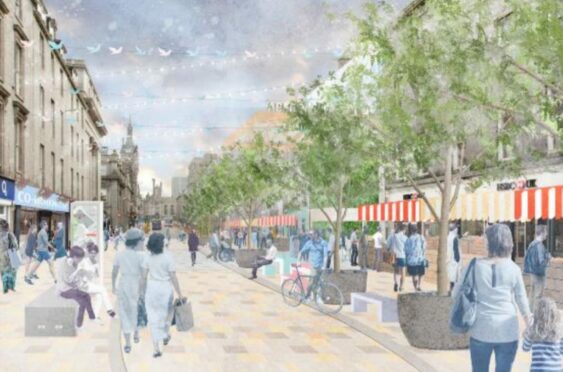Sir, – Weeks before the local elections, the council announces a long-awaited report to consider spending £111 million on two much-needed projects: the long-awaited Union Street regeneration, at a cost of £11m; and £100m on a beach overhaul.
As The P&J reported, an “eye-watering” amount of money, and sadly, a report shrouded in controversy, because it stresses a condition at the wish of the city’s top officials to divide the once iconic Union Street by prioritising the pedestrianisation of the Market Street to Bridge Street stretch but gives absolutely no indication of how this will negatively affect public transport users, and taxi drivers who have been inconvenienced by this diversion during the Covid lockdown.
Secondly, “a clean, repair and spruce-up” will in no way return the facades of the once architecturally magnificent frontages of the Granite Mile to their former glory.
Succeeding council planners, in the oil-rich years, surrendered architectural splendour for the convenience of the “concrete block” mentality, and Union Street has suffered.
The plan is to spend £11m-plus on a half-baked plan for Union Street but there is no mention, for example, of how to deal with the crumbling streets that back on to Union Street between Crown Street and Market Street, which are in more decay than Union Street, a reminder of Dickensian London.
Let the people decide.
John Young, Anderson Drive, Aberdeen.
Thanks for safety net of Westminster
Sir, – It would seem Nicola Sturgeon always has to be different, ever intent on reminding the UK Government and ourselves that she’s in charge of Scotland.
I say different because England has already lifted Covid restrictions, but not so Ms Sturgeon who decrees this won’t happen here until March 21 (Press and Journal, February 23).
But there’s ambiguity, for while saying mask wearing will be out, the Scottish Government intends to “strongly recommend” people continue to wear face coverings after March 21. What kind of a daft, confusing and misleading statement is that?
England has sensibly taken the view that Covid is something we’ve got to live with in the same way as we live with the flu. Doubtless the virus will mutate again but that’s for the future to deal with, for the here and now we need to get our lives back and the country back to normal.
The SNP continually knocks Westminster but what a sorry state an independent Scotland would be in had there been no UK input at every turn of this pandemic.
Keith Fernie, Drakies Avenue, Inverness.
Find a way to pay for more testing
Sir, – The current testing scheme in place to combat Covid is costing the taxpayer around £2 billion a month. This is unsustainable and rightly the prime minister has announced that this will be phased out and, with a few exceptions for the elderly and most vulnerable, free testing will no longer be available after April 1.
Never one to miss an opportunity to pick a fight with the UK Government, Nicola Sturgeon complains that Scotland wants to continue testing but the decision was taken by Westminster and funding was on a four-nation basis.
Given that health is a fully devolved matter there is nothing to stop Scotland continuing its testing programme should it choose to, it will just need to find a way to pay for it.
The Scottish Government could choose to fund this out of the largest settlement grant it has received since devolution began, it could use some of the additional funding it has received to tackle the effects of the virus, it could earmark the new health and social care levy to fund continued testing, or it will need to rework department budgets to fund this policy.
There are numerous options available to them to continue their current testing regime but wouldn’t it be better to continue with the four-nation policy and for the Scottish Government to follow the UK Government lead by actually trusting the public to do the right thing rather than expecting the taxpayer to continue to pick up the tab for these costs?
Mhairi E Rennie, Finlayson Street, Fraserburgh.
